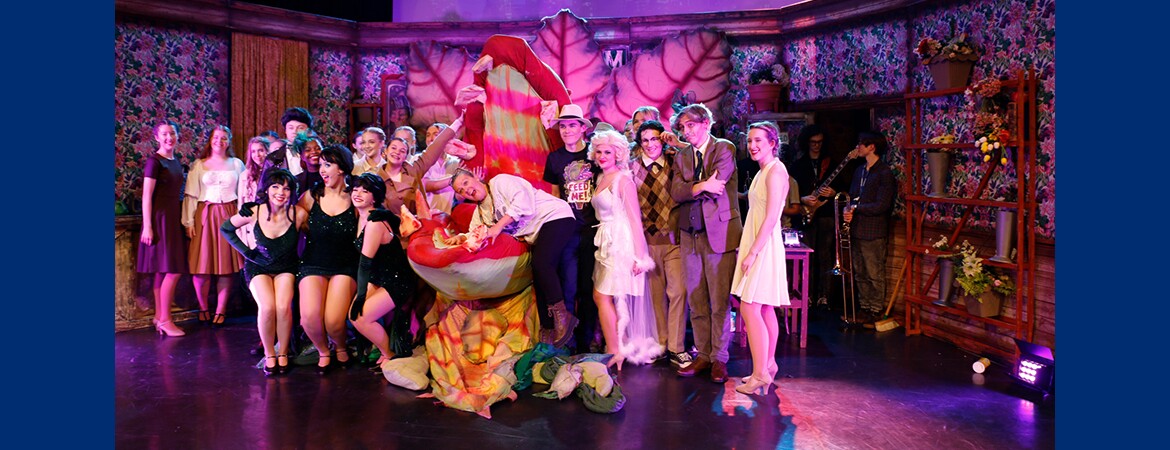Little Shop of Horrors review – a gleefully ghoulish opening evening
Back
The cast and crew of Winstanley’s latest musical germinate a perfect crop of horticultural hilarity, horror and heartbreak
Full spoiler warning in effect
There’s a moment in Little Shop of Horrors where our ‘hero’, Seymour, realises he can trade the flesh and viscera of unwitting murder victims for great personal gain. It’s an opportunity for a selfish achievement of the success, fame and belonging that has eluded him his whole impoverished life. This bargain is one that the cast and crew of Winstanley’s Little Shop adaptation seem to have lived out themselves, only they’ve inverted it somehow, selflessly trading their own blood, sweat and tears for the entire satisfaction of their audience through a frankly astonishing display of musical, vocal and acting talent.
And if the standing ovation of the opening night is anything to go by, audiences are very hungry for more. “Feed me, Seymour,” indeed.
This most recent Winstanley musical is an adaptation of the classic 1982 off-Broadway comedy-horror rock musical. It’s the story of Seymour Krelborn, a poor orphan living in an urban hell. He toils with his co-worker and secret love interest Audrey in an ailing flower shop, and each of them suffer in their own way with poverty and failure. But after discovering a fantastical plant with a taste for human flesh, their lives begin to change…
Spurred on to cult-classic status by the 1986 movie adaptation, Little Shop has become a beloved musical – but a challenging one to get right, in this writer’s estimation, because it asks so much of the cast. Comedy is a key ingredient, of course, but it also asks us to experience something approaching horror, and it also requires us to feel sympathetic for (at least some!) of its cast of misfits and victims. It’s a tall order for a young group of people to take on – but the outrageously talented performers of Winstanley College make it look effortless.
As Crystal, Ronnette and Chiffon (the trio of characters who narrate the story), Erica Stewart, Rachel People and Lily Hewitt open the show with energy and wit with the iconic ‘Little Shop of Horrors’ prologue theme. Their stage presence, poise and vocal power absolutely recall the talents of the iconic doo-wop girl groups from whom their characters take their names, and they’re a delightful fixture from start to finish – the vital glue which holds the whole thing together.
Their performance is wonderfully supplemented by a tremendous ensemble of accomplished dancers and singers who twirl and twist their way through a variety of tasteful and energetic routines, best exemplified in the fantastic choreography and direction of ‘Skid Row’. Some youth productions can sometimes feel a little ‘empty’ compared to big-budget professional efforts – after all, it takes a lot of talent and confidence to fill out a stage - but this top-drawer troupe bursts the seams of the show with animation and vitality.
The aforementioned ‘Skid Row’ introduces us to our main characters. There’s Tiago Cosoul as failing shop owner Mr Mushnik – his amusingly cantankerous performance erupts into something altogether more chaotic and hysterical in ‘Mushnik and Son’, a duet between Mushnik and Seymour that reflects the easy chemistry and camaraderie the members of the cast share with one another.
Mr Mushnik is half surrogate father, half slave-driver to downtrodden protagonist Seymour, played by Callum Carter. Seymour is a tough role because it was done so superlatively by Rick Moranis in the 1986 film adaptation – but Carter imbues the role with a convincingly nebbish charm which makes it all his own and holds attention from start to finish. He pins down the insecurity and pathetic nature of Seymour not just in the melody and lyrics of his vocal performance and his impeccable comic timing, but also in his stage presence and talent for physical comedy. His pining and fawning for Audrey kept pulling chuckles from the audience, but it was the faux-macho muscleman posturing on a stoop which drew one of the night’s biggest laughs.
Perhaps the most charming performance comes from Maiya Critchley who plays Audrey, the object of Seymour’s affection. Critchley walks a wonderfully fine line, capturing Audrey’s vulnerability and struggle with self-worth in a way that evokes genuine pathos without pulling the tone of the musical down into outright misery. This is especially apparent in her beautiful vocal effort in ‘Somewhere That’s Green’, which is not only touching but also nails the somewhat-cynical tone of Audrey’s yearning for ‘a washer and a dryer and an ironing machine’ – and her delivery of the joke about the ‘big, enormous twelve-inch screen’ is likely the third-most wickedly funny thing in the play.
What takes second and first place in that ranking? Expectedly, it goes to the villains. Liam Aspinall stars as sadist-dentist Orin Scrivello, and performs the outsized evil of the character with great gusto. His nitrous-addled cackles in the unhinged ‘Dentist!’ are an especially demented highlight. But, as is only right, it’s the big green guy who really steals the show…
The carnivorous plant Audrey II is a horror icon, and he’s brought to life devilishly by the silky voiceover of Toby Deveroux, who careens the puppet-based character wildly between its various modes of seduction, savagery and flesh-craving. Venerated lines and lyrics such as ‘Feed me, Seymour’ and ‘Does this look inanimate to you, punk?’ are a gift to any performer, and Deveroux is sure not to waste one delicious morsel in his scenery-chewing performance.
The cast excel in smaller roles too. Freya Lamb, Caitlin Lofthouse, Angelinah Nkomo and Noah Poole appear as a carousel of hangers-on for Seymour, and each of these talented actors and vocalists briefly steal the limelight as they tempt Seymour with even greater wealth, success and fame.
All the performances, main characters and bit parts alike, are notable for how brilliantly the cast execute on the rock vocals. But special credit must go to the band who (at least to this reviewer’s untrained ear) sounded like they might have been transported directly out of a West End orchestra pit. There’s some real range in the genre and tone of Little Shop’s music, as it cycles through Motown and doo-wop to rock and softer ballads, and the band nailed each and every one.
Likewise, the creative team and costume designers have obviously worked tirelessly to produce a real visual and aural treat. The set design and lighting authentically capture the 1960s New York setting, and the astonishing array of costumes (kudos to the kids for managing some lightning-fast clothing changes) perfectly complements the characters. There are productions that have tenfold the budget and do half as much, and that’s a triumph for Winstanley.
In short, everything just works, and works fantastically, right the way up to the downbeat closing moments. In line with the apocalyptic close of the original 1982 musical, Little Shop ends with Audrey II’s spawn taking over the world. It’s a fitting ending for this talented group of young people, as of the back of this fantastic night at the theatre, one can only expect they will go on to do the same.













